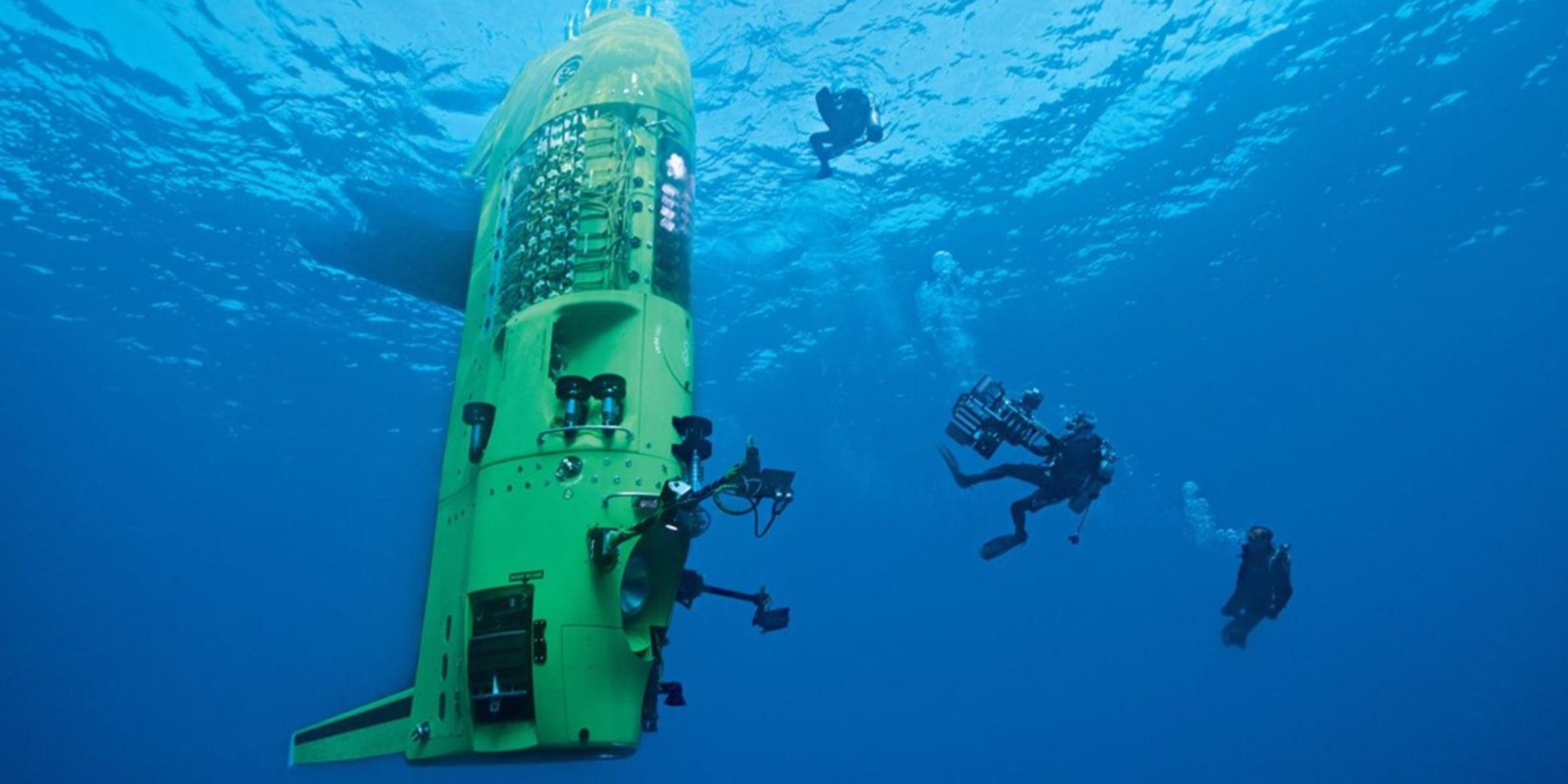
The first step is curiosity. The need to know more than you do. The desire to go where you haven’t.
Spurred by a need to get ‘eyes on’ with the deep ocean, pressurised spheres were developed to stretch the known boundaries of inner space. The 1930s-era bathysphere was the first use of a pressure sphere for manned observation of the deep sea. In 1960, bathyscaphe Trieste was the first to dive to Challenger Deep at the bottom of the Mariana Trench. Four decades later, the submersible DEEPSEA CHALLENGER was the first to go there with only one person on board: another curiosity-seeker, named James Cameron.
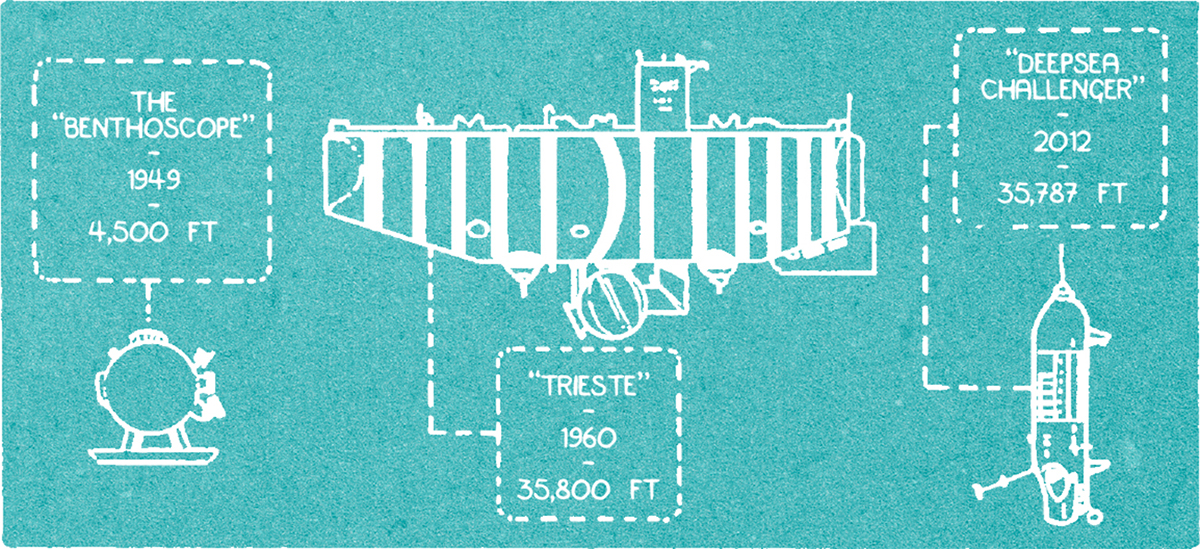
These three vessels represent human innovation and engineering to reach the depths of our oceans. Image: © Ruby Fresson.
1930s: William Beebe and Otis Barton
Begin with a bathysphere
In 1928, Dr William Beebe met Otis Barton. Beebe had plans to explore marine life below the twilight zone. He had strong scientific credentials, and a cushy job as Director of the New York Zoological Society’s Department of Tropical Research. Barton had engineering skills, a workable design for a diving sphere and money to build it. Barton convinced Beebe of the feasibility of his design, and the two men embarked on an adventure that would forever alter the narrative for humans underwater.
Together, they championed and built a spherical diving submersible which Beebe described as a ‘bathysphere’, from the Greek bathus meaning “deep” and sphaira or “sphere”. Spheres are the strongest shapes for resisting pressure. When water is displaced, it pushes against the side of whatever moved it with a degree of force. This force, or hydrostatic pressure, increases by one atmosphere (atm) for every additional 10 metres of depth.
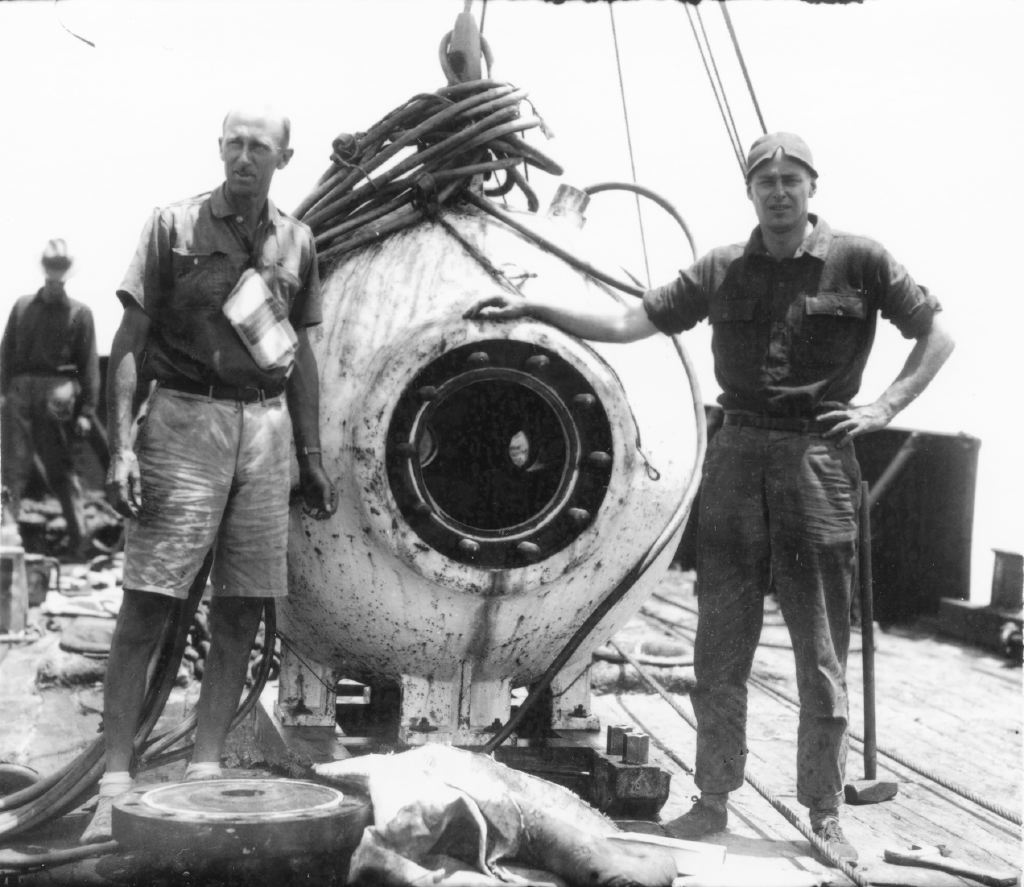
Dr William Beebe (left) with Otis Barton. Together, they championed and built a spherical diving submersible which Beebe described as a ‘bathysphere’, from the Greek 'bathus' meaning “deep” and 'sphaira' or “sphere”. Image: Wildlife Conservation Society, New York.
To withstand this, the 2 + tonne cast steel bathysphere had walls 3.8cm thick and an internal living space only 137cm wide. It had three portholes, each 20cm wide with 7.6cm thick fused quartz windows. At the time, fused quartz was the best material for transmitting light waves in the depths– including ultraviolet waves. A smaller sphere was less comfortable for the divers but provided greater strength against the compression of depth. If you had a choice between comfort and death, wouldn’t you take a few hours of discomfort over getting liquefied and pressure-popped out through a porthole?
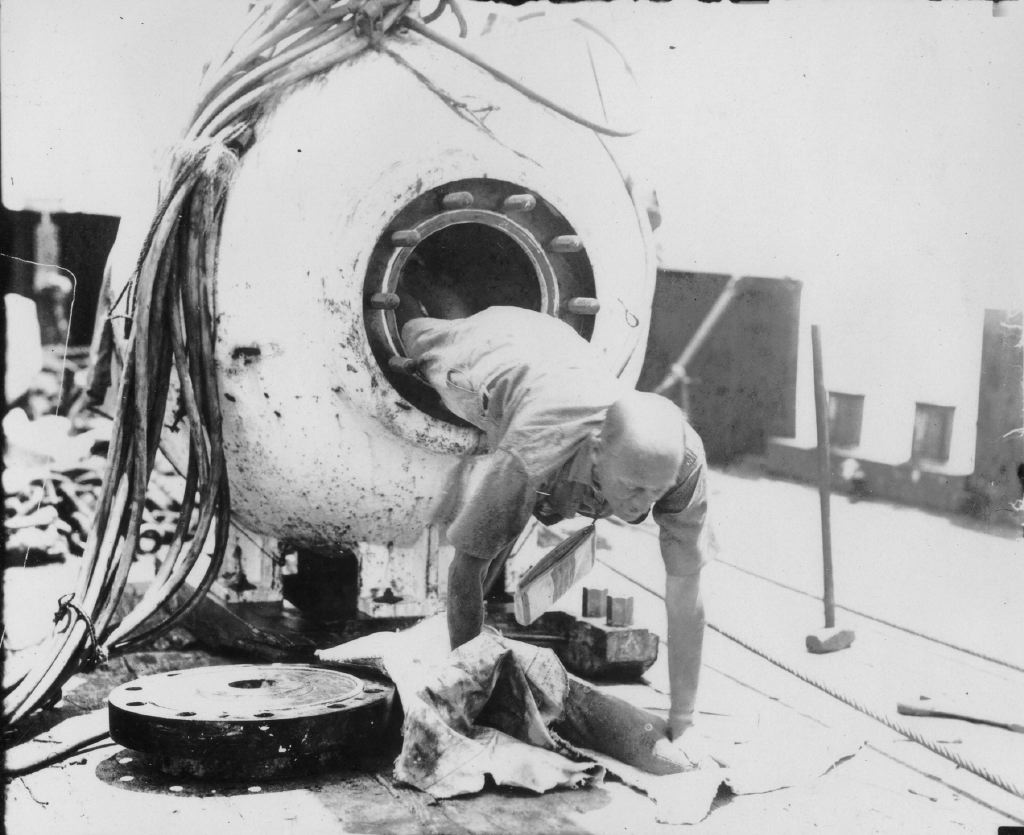
Beebe and Barton's bathysphere had walls 3.8cm thick and an internal living space only 137cm wide. Image: Wildlife Conservation Society, New York.
Beebe and Barton secured sponsorship from the New York Zoological Society (now known as the Wildlife Conservation Society), and later, the National Geographic Society to conduct a series of test dives in the waters off Nonsuch Island, Bermuda. The bathysphere was lowered into the water from a barge on a steel cable. The first two dives were unmanned, and the craft successfully lowered to 460 metres without springing a leak.
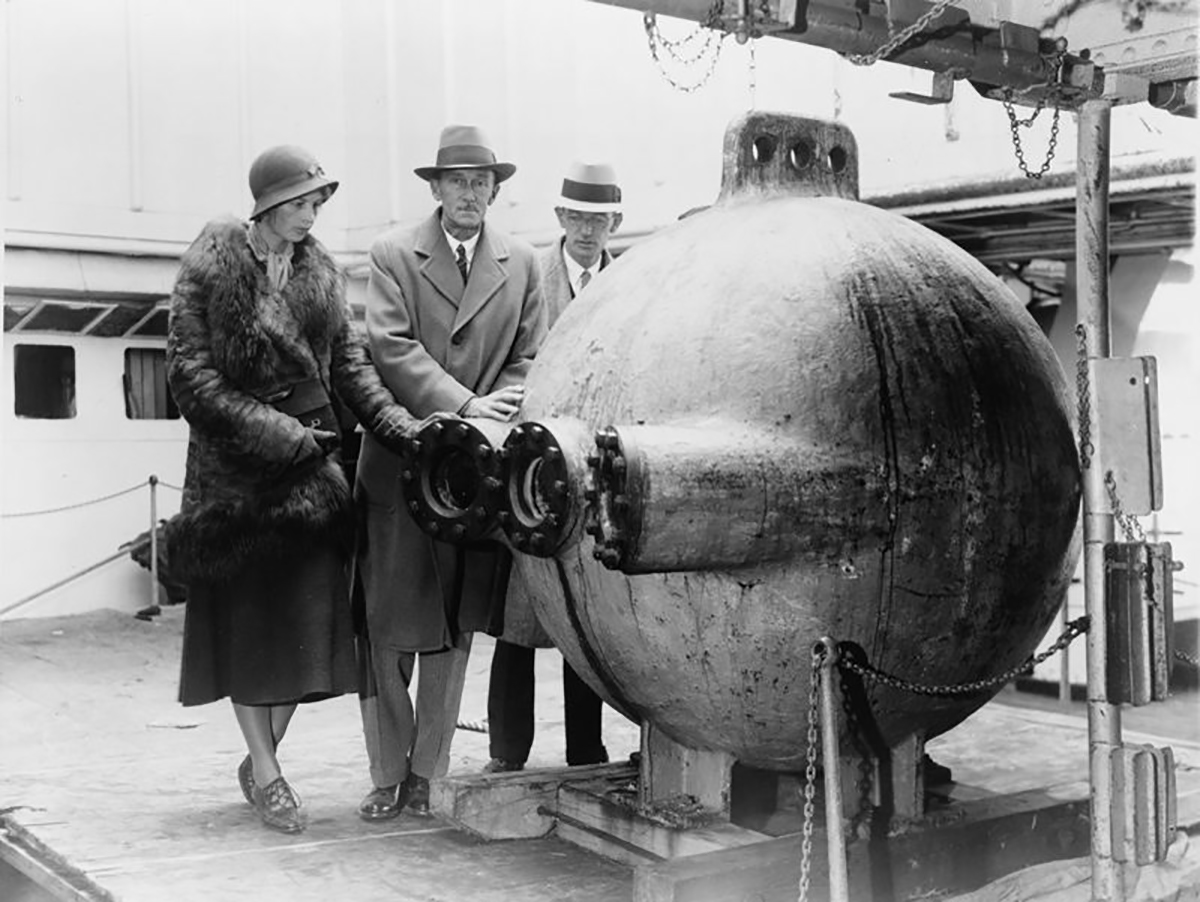
Gloria Hollister, William Beebe and John TeeVan next to the bathysphere (1932). Image: Courtesy US Library of Congress.
Inside the tiny internal space were Beebe, Barton, two cylinders of emergency oxygen, trays and drip pan for calcium carbonate (to soak up moisture) and soda lime (to do the same for carbon dioxide). It had an internal switchboard and 250 watt spotlight, telephone for communicating with the surface, and a manual palm fan mounted to keep the air from getting stagnant. No mention of snacks, but at least they could call room service.
On their first dive together, they noticed a small stream of water seeping past the door. Alarmed, they called the surface and requested that the bathysphere descent be sped up. Luckily, that was the correct choice as the increased pressure from the faster descent sealed the door.
This first manned dive was to 242 metres. From 1930-1934, Beebe and Barton made 16 dives in the bathysphere. On 15 August 1934, they reached a record depth of 923 metres, the limit of their cable, managing to stay at depth for five minutes.
There were other members of the team who rarely get a mention outside those in the know. Three of William Beebe’s exhibition members were women. Zoologist and oceanographer Gloria Hollister and carcinologist Jocelyn Crane recorded biological data and dive data respectively, as transmitted to them at the surface over the telephone.
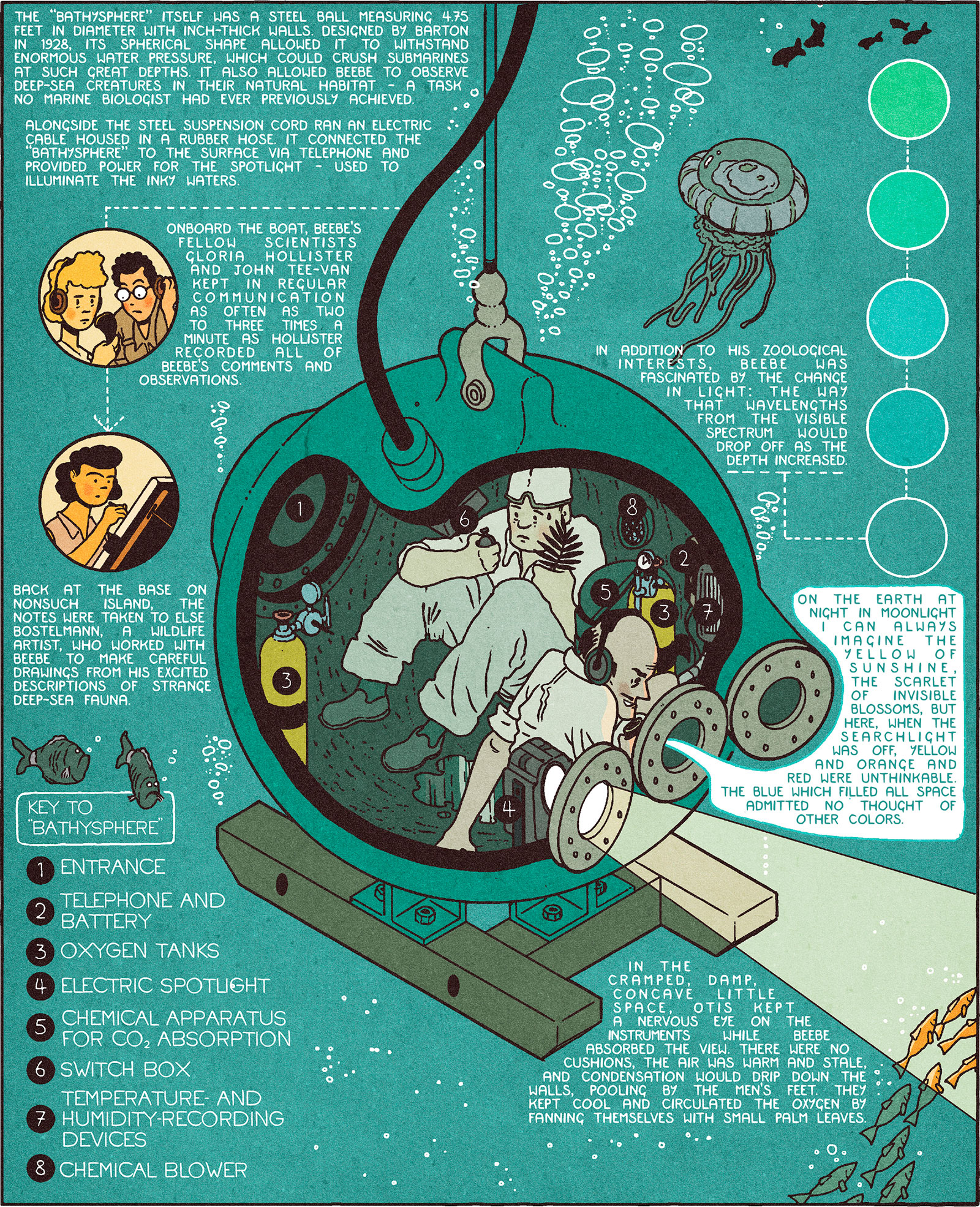
Artist Ruby Fresson's illustration of the interior of the bathysphere, with Barton and Beebe inside. Image: © Ruby Fresson
Hollister was the first woman to dive in a bathysphere, marking her 30th birthday with a dive to 125 metres on 11 June 1931. In 1932, Hollister set a women’s world record with a dive to 368 metres. Gloria also starred in Barton’s widely panned 1938 film Titans of the Deep, wherein Barton asserts himself as the inventor of the bathysphere.
Crane was a research associate at the Department of Tropical Research and in 1963, became its Director.
Exhibition illustrator Else Bostelmann recorded marine life details as transmitted to her by Dr Beebe over the bathysphere’s telephone. Her illustrations were featured in National Geographic. She drew creatures so fantastic, some believed that they couldn’t be real.
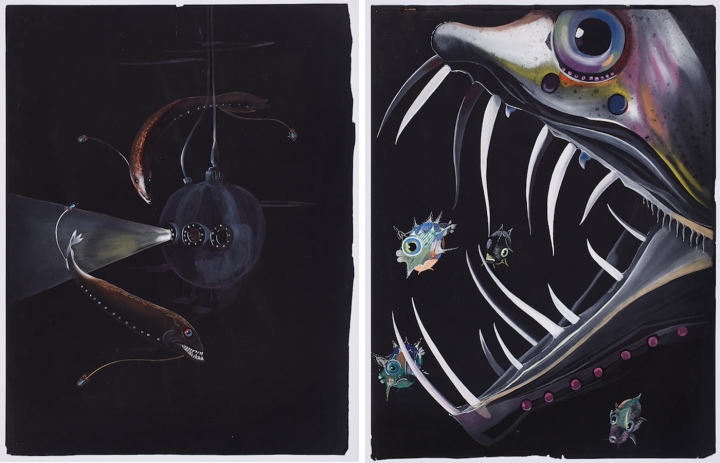
Else Bostelmann's drawing of deep-sea creatures, as described to her by Dr Beebe over the bathysphere’s telephone. “Bathysphaera intacta Circling the Bathysphere” and “Saber-toothed Viper fish (Chauliodus sloanei) Chasing Ocean Sunfish (Mola mola) larva”. Courtesy Wildlife Conservation Society Archives,
Barton wasn’t finished: he worked with the Watson-Stillman Company to build a more pressure-resistant sphere capable of diving to greater depths. He named it the benthoscope (benthos meaning ‘bottom’). This chrome-nickel sphere had slightly thicker walls, at 4.5 centimetres, and only two windows—one for looking out and one for looking down. In 1949, Barton dived in the benthoscope to 1,370 metres off Santa Cruz, California, a depth still unchallenged for tethered pressure spheres.
The bathyscaphe prior to its historic dive to the deepest part of the world ocean.
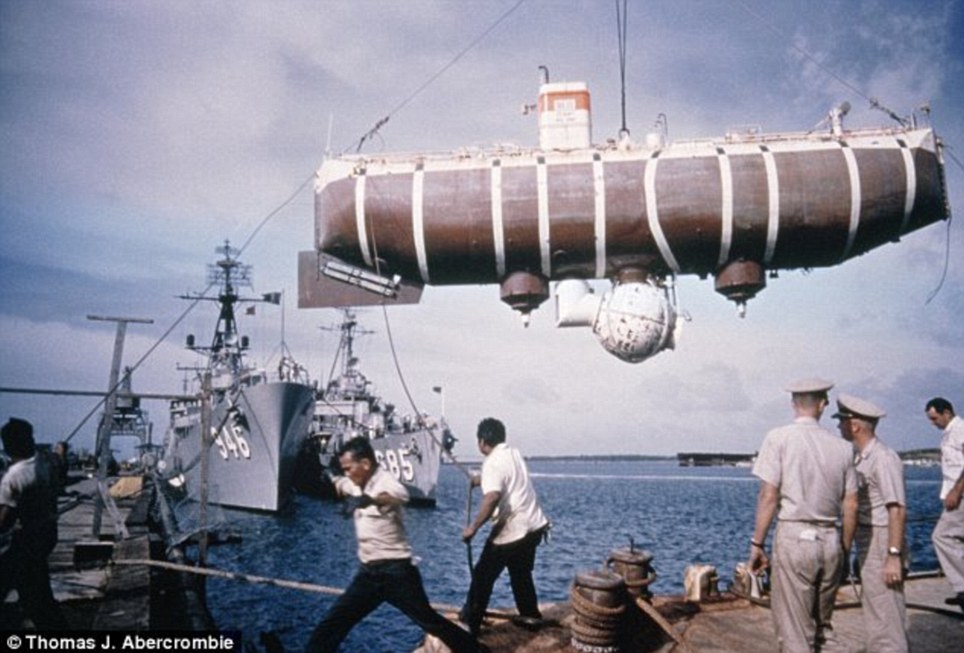
The bathyscaphe prior to its historic dive to the deepest part of the world ocean. Image: Courtesy Thomas J. Abercrombie, National Geographic Society. Image: Courtesy Thomas J. Abercrombie, National Geographic Society.
1960s: Don Walsh and Jacques Piccard in Trieste
Going deeper…
During the Cold War, and spurred on by the Soviet Union’s ground-breaking launch of Sputnik into outer space in 1957, the United States dedicated funding and personnel to send humans to an equally fantastic ‘inner space’ depth underwater. But before the Soviets and the Americans raced to put men (and animals) in space and the sea, a Swiss oceanographer was quietly working to develop a submersible that would open the oceans to deeper exploration than ever before.
Auguste Piccard was a physics professor interested in studying cosmic rays. To do this, he built a gondola, called FRNS after his sponsor, and took it to an altitude of 16,000 metres. Using a similar design of a sphere attached to a float, he then fabricated the world’s first bathyscape, FNRS-2, in 1948, to go the other way. It reached a depth of 1,380 metres. Modified and renamed FRNS it reached a depth of 3,749 metres in 1954.
If we needed stuff we had to develop it ourselves. Literally, necessity was the mother of invention. That is the burden of pioneers. — Don Walsh
Working with his son, Jacques, Auguste Piccard then constructed the bathyscaphe Trieste. Like his gondola, Trieste had a passenger capsule suspended below a float, but instead of a pressurized aluminium sphere and lighter-than-air helium, Trieste had a steel passenger sphere with 9 centimetre thick walls attached below a tank filled with lighter-than-water petroleum. For bathyscaphes, it was all about buoyancy control. To descend, petroleum was released from the tank. To ascend, 0.3 centimetre diameter electromagnetic iron shot was released from a ballast tank. Unlike the earlier tethered bathysphere, the Trieste had top-mounted propellers allowing it to manoeuvre independently through the water.
It was used by the French Navy until purchased by the US Navy in 1958 for Project Nekton.
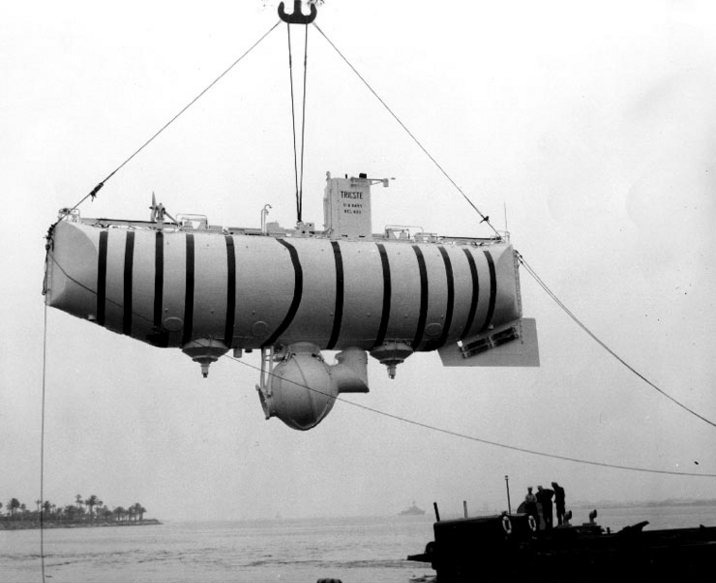
The TRIESTE was acquired by the US Navy for Project Nekton.
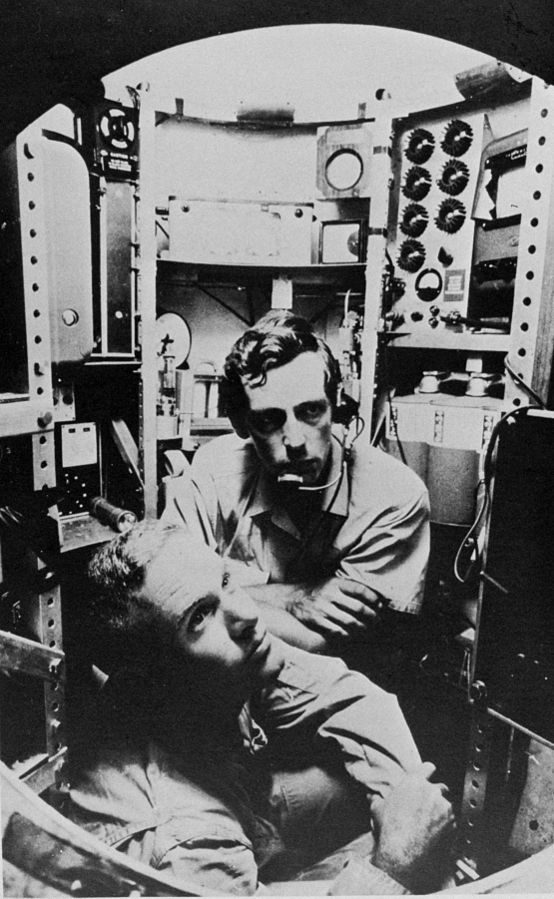
Lieutenant Don Walsh and Jacques Piccard in the bathyscaphe TRIESTE.
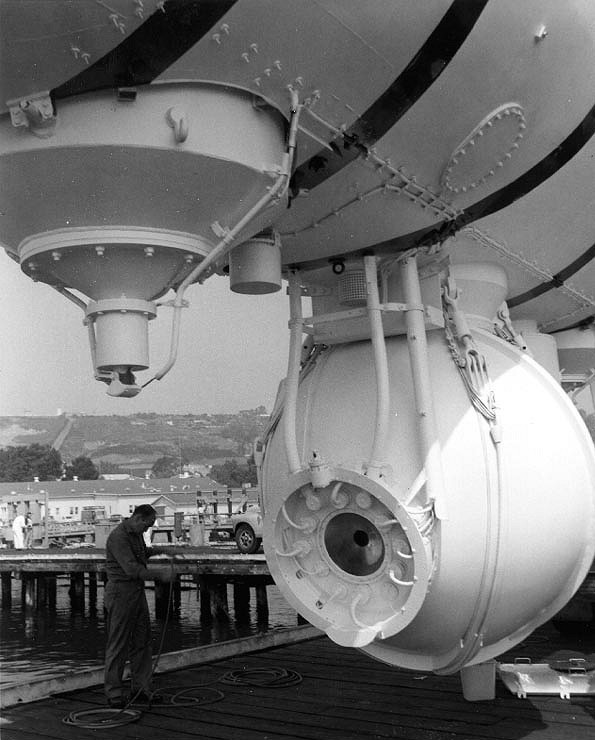
The pressure sphere of the TRIESTE and its plexiglass window
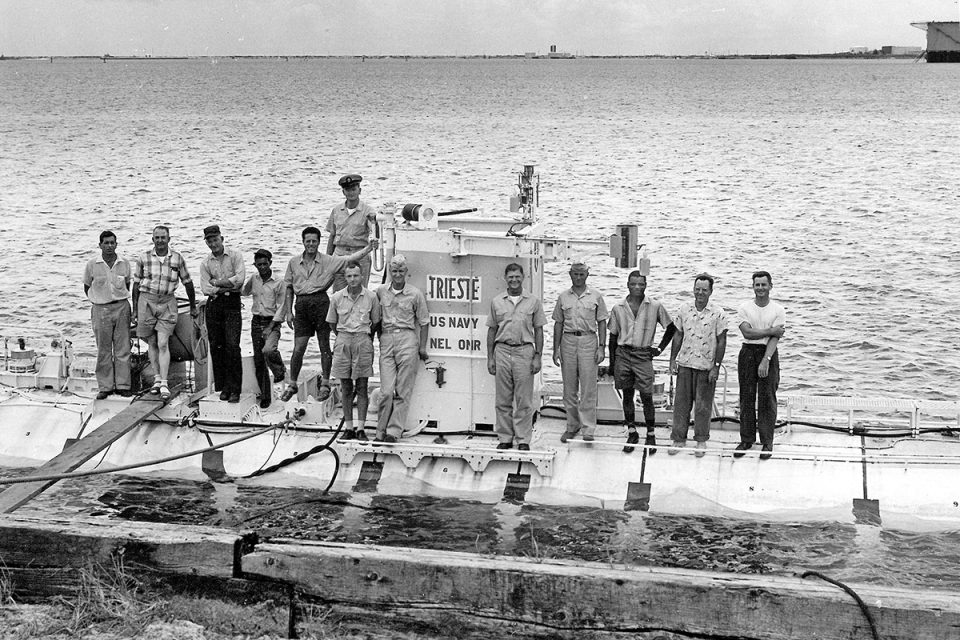
The Project Nekton team on board TRIESTE in Apra Harbour, Guam, 1959. Courtesy: Don Walsh.
Project Nekton was the codename for the six test dives and a final dive to the deepest known part of the ocean, Challenger Deep, conducted by the US Navy using the bathyscaphe Trieste. The Navy added larger petroleum and ballast tanks, overhauled the communications system and installed a steel-alloy Krupp sphere, pushing the bathysphere’s maximum depth from 6,000 to 11,000 metres. Named for the Nektons that actively swim against the current, it was a suitable name for the project reaching to the depths of the world.
Roughly 332 kilometres off the coast of Guam lies the Mariana Trench. Within the trench is a narrow crevice where the Pacific Plate meets and subsides beneath the Mariana Plate. This is Challenger Deep. HMS Challenger took soundings during its 1872-76 expedition and HMS Challenger (II) resurveyed and recorded its depth in 1951. Sonar bathymetry has recorded a possible maximum depth of almost 11,000 metres at its deepest point. Diving to its depths is the underwater equivalent of putting a man on the moon.
The bathyscaphe was towed to the site behind the US Navy tugboat Wandank. It took four days to arrive on site. The seas were rough, and the bathyscaphe was damaged. The surface telephone, required for last minute surface-to-sub instructions, and the vertical current meter (useful for recording descent) had been torn free. The bathymetry team conducted soundings and determined that they were in the vicinity of Challenger Deep. Aquanauts Lieutenant Don Walsh and Jacques Piccard readied themselves for the 8.5-hour dive. The Trieste was deployed on the morning of the 24 January 1960 and began its descent.
Only 90 metres down, they hit a snag. The thermocline (layers of differing water temperatures) within the Mariana Trench was greater than expected, Trieste was too buoyant and unable to descend. In fact, it seemed to be rising back to the surface.
Rectified by the release of additional petroleum, they finally breached the thermocline at 200 metres and began to descend at a rate of one metre per second. Now that that was sorted, they could deal with their clothes that had become wet during the transfer over from Wandank. The temperature inside the sphere would drop to 4 degrees Celcius; so Walsh and the 2 metre tall Piccard changed clothes, together, in a tiny 1.9-metre diametre ball, 457 metres below the surface.
After surpassing 792 metres, they slowed their descent, ever wary of the approaching ocean floor. At 9,906 metres, they heard a loud bang. They hadn’t died nor did they see any water flooding the bathysphere, so kept going. Meanwhile, the surface crew had received a mysterious message from the Commanding Officer and Director of the Navy Electronics Laboratory telling them to call off the dive. Nonplussed, the Director of Project Nekton radioed back that the Trieste was already on its way down. Finally, at 13:06 hours, five hours into their descent, Trieste gently landed on the bottom of Challenger Deep and radioed their depth to the surface: 6300 fathoms (10 913 +/- 5 metres).
At the bottom of the ocean, as in space, there are questions about life we want to answer. But, spotting sea life with a torch through a tiny window, in the soup of suspended sediment stirred up by the landing, isn’t easy. During their 20 minutes on the bottom, Walsh and Piccard saw what they believed to be a flatfish and were overjoyed. Then, peering through the porthole, Walsh spotted the cause of the loud noise — the large plexiglass viewing port in the entry tube was fissured, potentially compromising their ability to exit Trieste on the surface. If it didn’t open, Walsh and Piccard were looking at a long few days towed behind a ship to port for manual removal. They decided to surface.
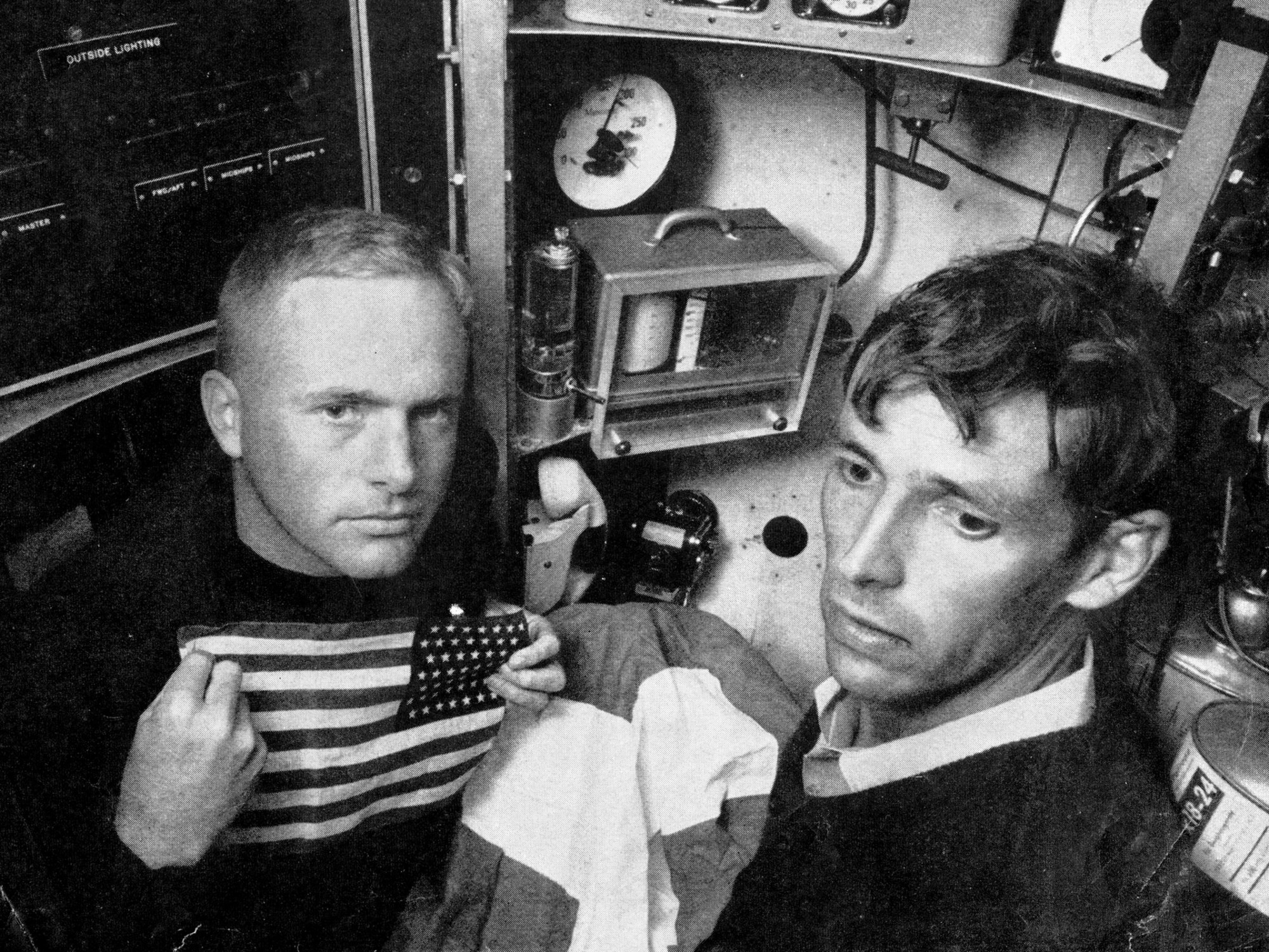
Lieutenant Don Walsh (left) and Jacques Piccard in the bathyscaphe. Courtesy Don Walsh.
Releasing the lead shot used as ballast, the Trieste surfaced three hours later. Walsh and Piccard spent the ascent checking instruments, wondering about the cracked window and eating chocolate bars.
On the surface, Walsh and Piccard were lauded as heroes. 10,913 +/- 5 metres is still the deepest humans have ever gone, a triumph for human endeavour in undersea exploration. Project Nekton was about funding and utilising the technology to get there, and they got there. After the Challenger Deep dive, the Navy never let Trieste dive below 6,000 metres again.
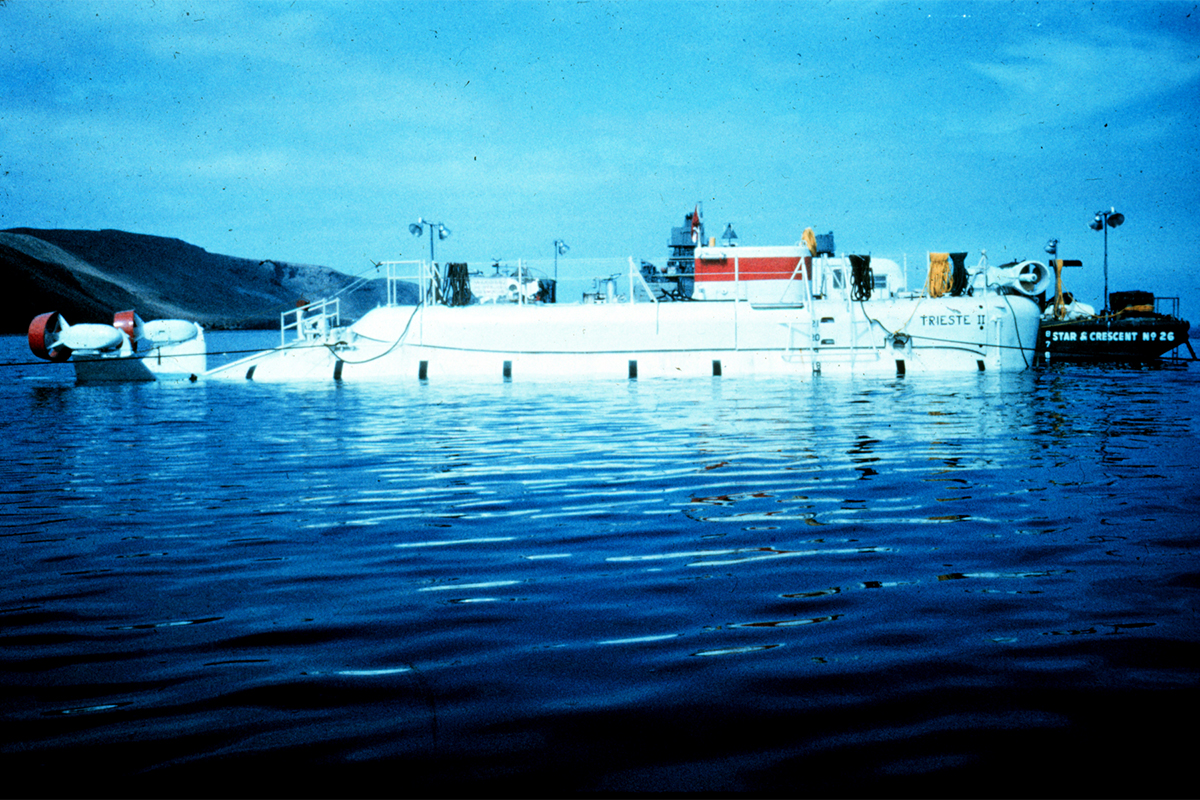
The TRIESTE was modified and renamed TRIESTE (II) but never again dove below 20,000 feet. Image: US Naval History and Heritage Command.
The legacy of the Trieste
The race to reach the deepest point may have been over, but the military utilisation of bathyspheres wasn’t. In 1963 the US Navy lost the submarine USS Thresher. This exposed serious limitations in their capacity to recover sensitive materials and kick-started the Deep Submergence Systems Project (DSSP). From the bones of Trieste, they developed Trieste (II).
First, the Krupp sphere was replaced with the original Terni sphere (rated for shallower dives, up to 3,600 metres). They added a new petroleum float, more powerful propellers, and replaced lead-acid batteries with silver-zinc. In many ways, it wasn’t really the same bathysphere at all. Trieste (II) carried out a number of deep-sea missions, including finding lost bombs and locating USS Thresher.
Trieste (II) had a number of additional modifications that brought it more in line with modern deep submergence vehicles. These included a manipulator arm, samplers, sonar, underwater connectors, and high-pressure housings for lights and cameras, and even an early remotely operated vehicle (ROV). Renamed in 1964, it was retired in 1984 and is now on display at the US Naval Undersea Museum in Keyport, Washington.
The 1960s and early 70s were the heydays for bathyscaphes, submersibles, underwater habitats, and pressurized dive suits as the world reacted to the space age. Although the Vietnam War squeezed funding for technologies without military application, deep-sea diving for oceanographic purposes became more common. At the time of the Trieste dive, there were only two operational submersibles in the world but by the early 1970s, there were up to 200 submersibles.
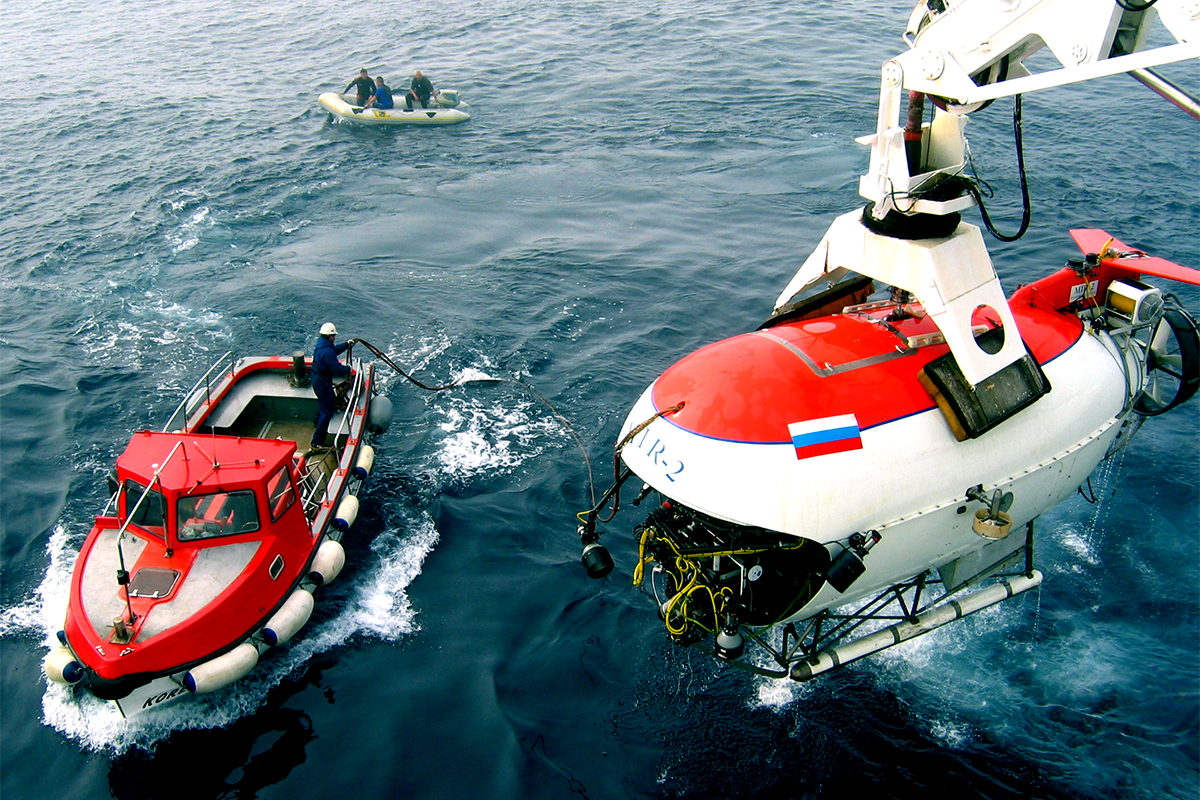 MIR 2 is deployed from Academik Mystislav Keldysh during the Last Mysteries of the Titanic project in 2005.Image: Courtesy Brenden Ward.
MIR 2 is deployed from Academik Mystislav Keldysh during the Last Mysteries of the Titanic project in 2005.Image: Courtesy Brenden Ward.
Currently, there are a handful of operable deep-diving submersibles (rated deeper than 4,500 metres) around the world. These include DSV Alvin, built 1964 (and still used by Woods Hole Oceanographic Institute), and Japan’s more recently manufactured DSV Shinkai 6500 (しんかい,), China’s DSV Jiaolong ( 蛟龙号), the French DSV Nautile, as well as Russia’s two MIR submersibles and Konsul class of DSVs.
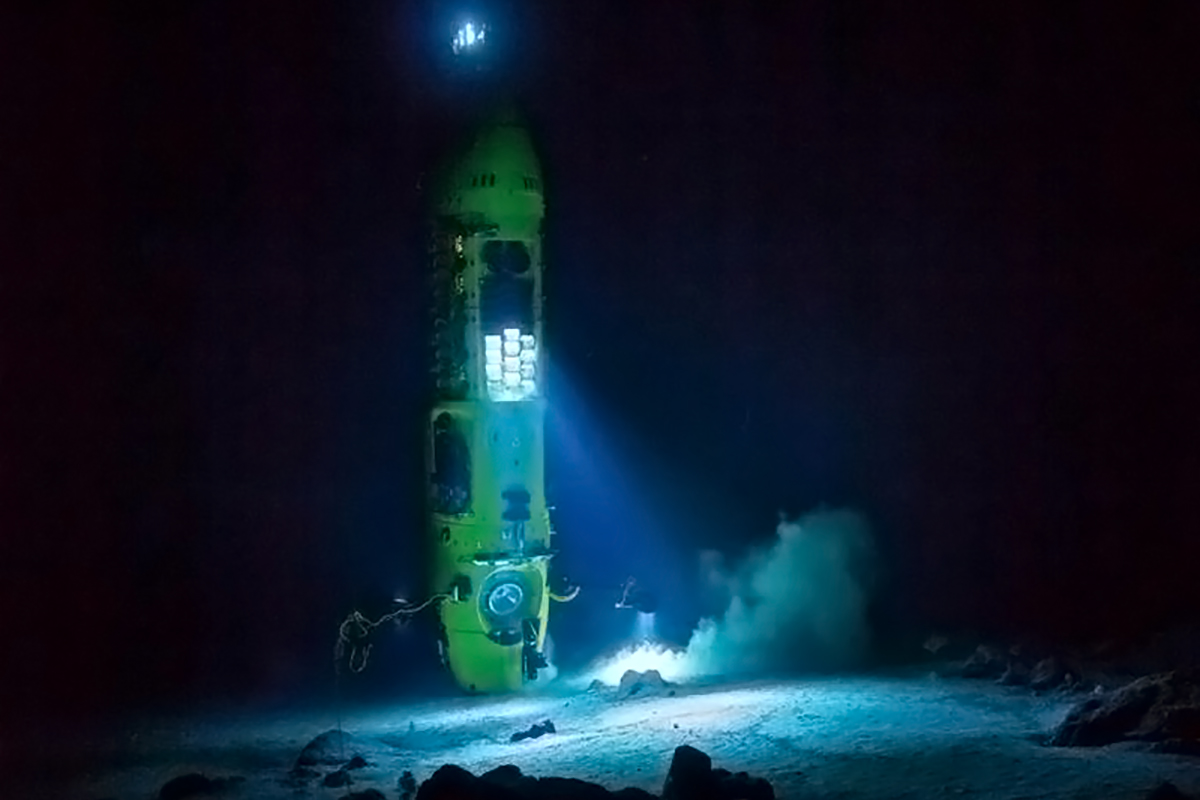
DEEPSEA CHALLENGER, the first to reach the bottom of the Mariana Trench with a solo pilot. Image: Mark Thiessen/National Geographic Creative.
2012: James Cameron and the DEEPSEA CHALLENGER
Going solo…
In 1968, fourteen-year-old James Cameron visited the Royal Ontario Museum to see Dr Joseph MacInnis’s underwater habitat Sublimnos on display outside the museum. Inspired, Cameron planned and built his own miniature habitat (named Sealab 3) and sent it to the bottom of the river with one lucky passenger inside: a mouse. The mouse returned unscathed from its terrifying solo plunge into the depths of Chippawa Creek near his home in Canada. Forty-four years later, James Cameron would complete a similar journey.
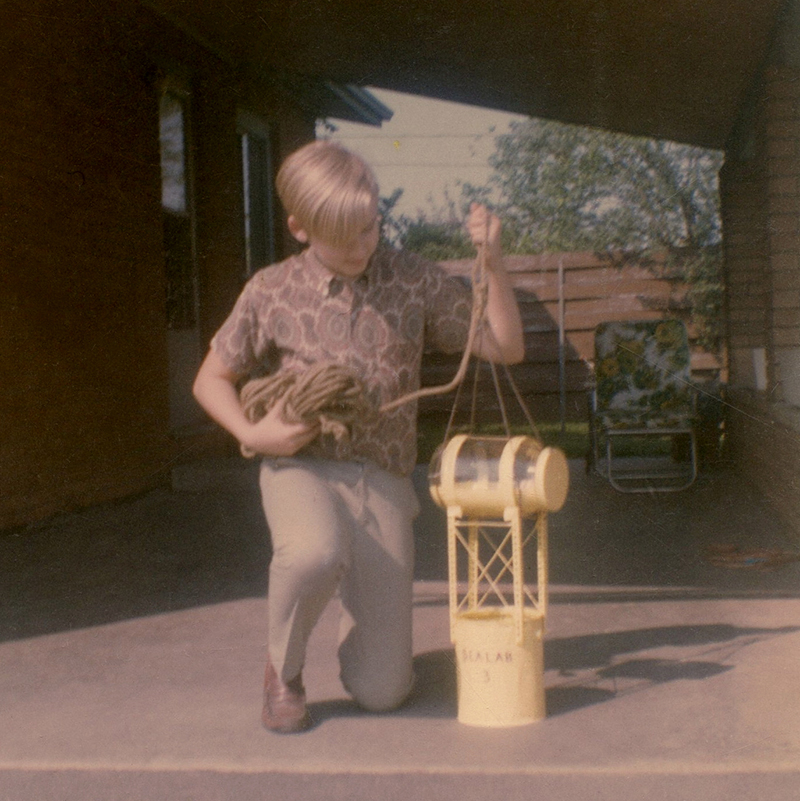
In 1968 fourteen-year-old James Cameron built his first submersible vessel called SEALAB 3, which he deployed in Chippawa Creek (Canada) with his pet mouse as passenger. The mouse survived unscathed. Image: Courtesy James Cameron.
Most pressurised spheres are overengineered to extend the life of the submersible, making them more cost-effective, and protect the sphere in case it accidentally goes below its maximum rated depth. For Cameron’s one-person submersible DEEPSEA CHALLENGER, this wasn’t necessary. The design and build team already knew that it was going to the deepest place in the ocean, so they were able to construct it specifically for where it was to go and what it was to do — a solo dive to Challenger Deep.
DEEPSEA CHALLENGER is an art and science creative collaborative design led by the Acheron Project Pty Ltd, a company developed by James Cameron and Australian Ron Allum, for a project seven years in the making. It was assembled in relative secrecy in Ron and Yvette Allum’s engineering workshop in a back street in Leichhardt.
The submersible comprises a pressurised 127cm diameter pilot sphere suspended via specialised webbing. The submersible is uniquely vertically-oriented. Syntactic foam is usually only used on the top of submersibles for buoyancy, but here makes up the main flotation beam. By building the entire frame out of Isofloat™ syntactic foam, invented by Ron Allum for the project, Cameron and his team were able to compensate for the weight of all the pressurised equipment it carried externally, including watertight lithium-ion battery packs, an ingenious primary drop-weight system for ascent, and pressure-balanced oil-filled LED lights, all capable of operating at 16,500psi (11,000 atm), or just slightly more than the projected maximum pressure at Challenger Deep.
Test dives were conducted in Sydney Harbour and at Jervis Bay. Additional test dives were conducted in the New Britain Trench, off Papua New Guinea, on the way to the Marianas Islands. Like the previous expeditions before this, it wasn’t just about the dive, but what would be seen and found on the dive. A multi-disciplinary team of scientists were also along for the ride: it’s not that often you can get a front seat to the biological and geological mysteries of Challenger Deep.
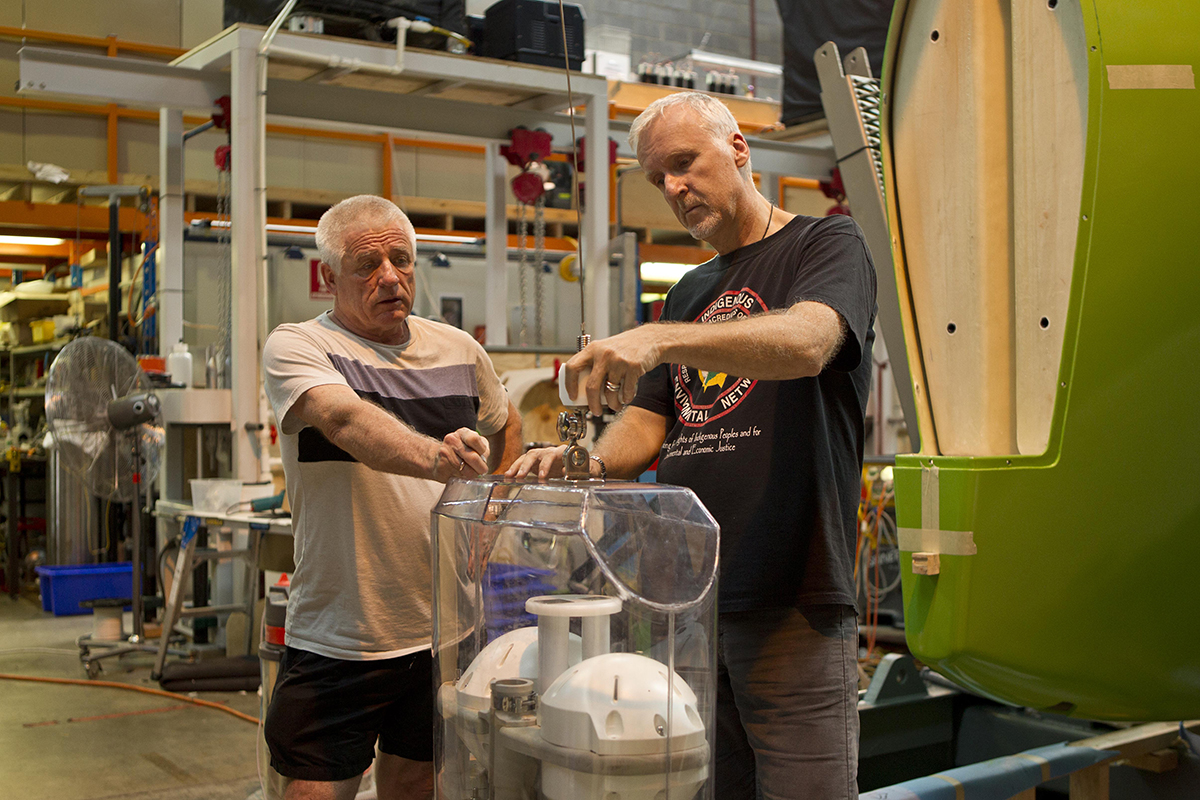
James Cameron and Ron Allum in the workshop in Leichhardt, 2011. Image: Courtesy Ron and Yvette Allum.
Cameron knew that the only way to achieve it was to gather a team that would ask ‘what if?’ instead of saying ‘we can’t’, so he hand-picked a team of over 100 people to conduct all operations associated with design, build, lab and field testing prior to the record dive. Edge Innovations (responsible for the Cab and Flatbed models in Cameron’s science fiction classic feature film The Abyss, and the robotic killer whale in Free Willy, among many other amazing builds) built the submersible lower pod and the failsafe weight-release system. There was a Sub Team, Launch and Recovery Team, Lander Team (for DOV Mike), a Communications Team, people in charge of expedition logistics, expedition partnerships, a film director (Cameron would be a bit busy), expedition journalist and a doctor.
A total of 8 test dives were conducted in Sydney Harbour and in the New Britain Trench, off Papua New Guinea, on the way to the Marianas Islands. In the New Britain Trench, Cameron set a record for the deepest solo dive, reaching a depth of 8,265 metres. The expedition lander, DOV Mike, verified by video the existence of giant amphipods (extremely large deep sea shrimp). Deep sea, or abyssal gigantism, is an adaptation seen in species resident in cold, low oxygen and high-pressure environments.
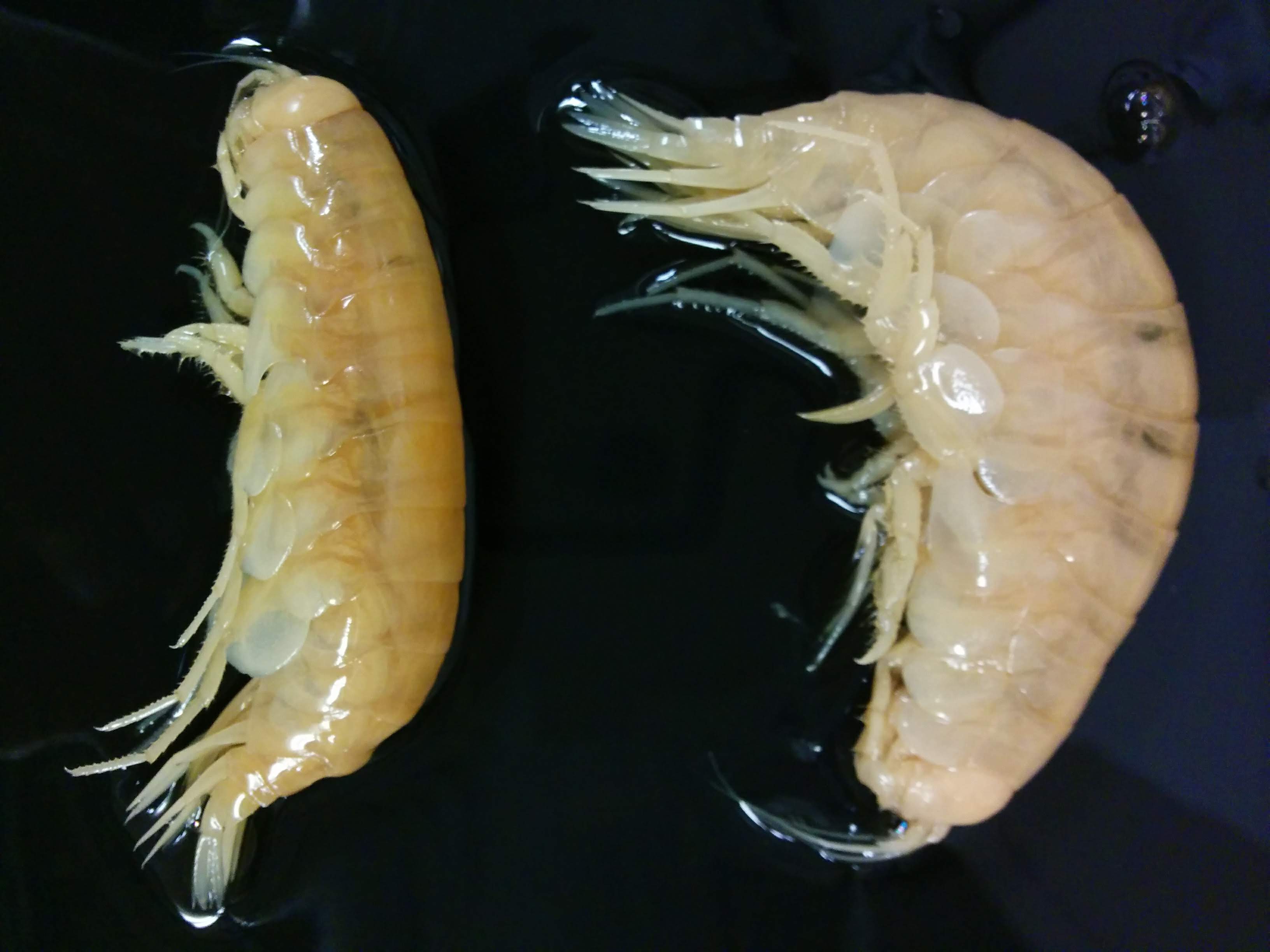
These shrimp-like crustaceans were collected 8,367 m deep in the New Britain Trench off Papua New Guinea. Giant amphipods (Alicella gigantea) are important scavengers in deep-sea ecosystems, and these specimens were caught using a trap baited with fish. Image: Charlotte Seid/Scripps Institution of Oceanography University of California San Diego.
On 26 March 2012, with Trieste pioneer Don Walsh watching from on board tender Mermaid Sapphire, the DEEPSEA CHALLENGER submersible started its descent into Challenger Deep. The interior diameter of the pilot sphere is 121 cm, a bit of a squeeze for Cameron’s 1.87-metre frame. To prepare for the dive, he studied Pilates and assessed various positions for their suitability within the space. After a gruelling 2 hour and 37-minute descent, Cameron touched down 10,898 metres deep at the bottom of the Mariana Trench. He was the first person to go there alone – and surpassed his own solo dive record, set just days before.
Time moves quickly in inner space. Cameron had planned to spend six hours on the bottom taking samples and collecting footage. He managed a peek outside and spotted amphipods (deep sea shrimp), but one of the lines in the externally-mounted manipulator arm sprang a leak, disabling its use and leaking hydraulic fluid past his single viewport. More than two hours later he lost the use of one of his starboard thrusters. With one thruster he still could have spun doughnuts on the sea floor but could not make any forward progress. For safety’s sake, Cameron decided to cut it short and left the alien deep after 2.5 hours. Flipping the switch to release the drop weights, he shot to the surface in just under 90 minutes.
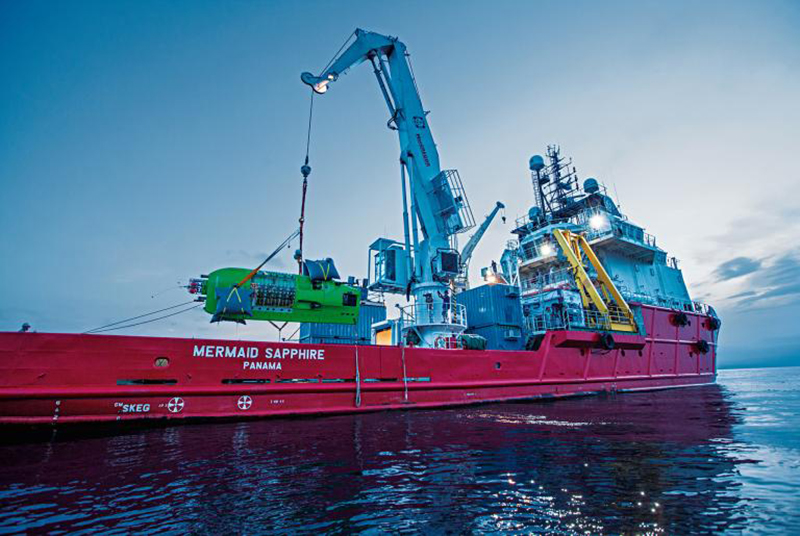
James Cameron surfaces after a successful dive to Challenger Deep. Image: Mark Thiessen/NatGeoCreative.
For Cameron, this was the realisation of a life-long dream. Every step he’d taken, from his illustrations and mechanical builds during his high school science club days, to the patented underwater helmets used on the The Abyss, to the remotely operated vehicles and lighting systems developed for Titanic, Ghosts of the Abyss, Last Mysteries of the Titanic, Expedition: Bismarck and Aliens of the Deep expeditions, to his 72 submersible dives, every step along the way, he was refining his craft and building his arsenal to achieve this goal.
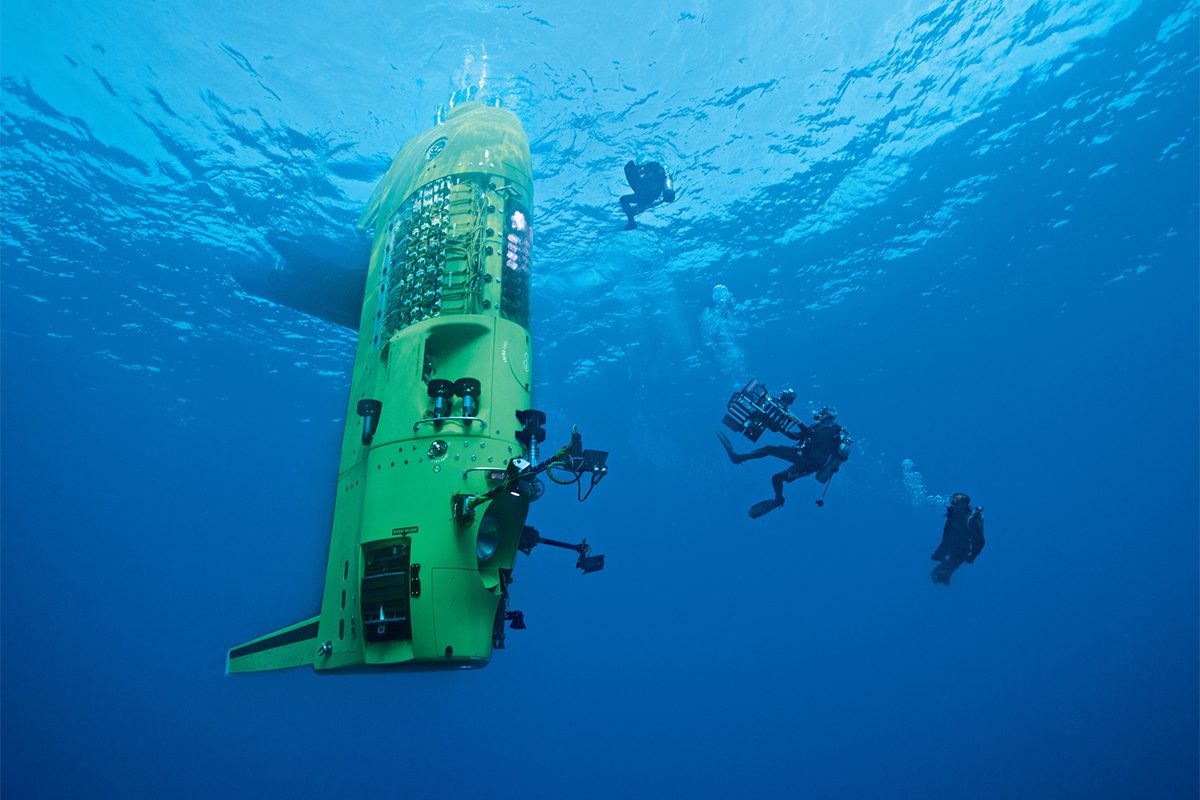
On March 26 2012 Cameron made a record-breaking solo dive to the earth’s deepest point, the bottom of the Challenger Deep in the Mariana Trench. Image: Mark Thiessen/NatGeoCreative.
Challenging the Deep
What prompted Beebe, Piccard, Cameron and others to shut the hatch and achieve these great feats? Cameron states that what drove him to dive to the ocean depths in a tiny pressurised circle is the most fundamental of human behaviours: curiosity. William Beebe dedicated the first chapter of Half Mile Down (1934) to “the First Wonderer”. Scientists at the University of California have found that our brains work better and retain information longer when our curiosity is aroused. I asked Cameron’s long-term collaborator Dr Joe MacInnis why he thought James Cameron made and succeeded at this dive and he said, ‘he has an alpha curiosity and a super glue memory and the ability to create team genius. We [the DEEPSEA CHALLENGE team] were inspired by a man who invested seven years of his money, mind and his life for what he believes in: science-driven exploration and failsafe engineering’.
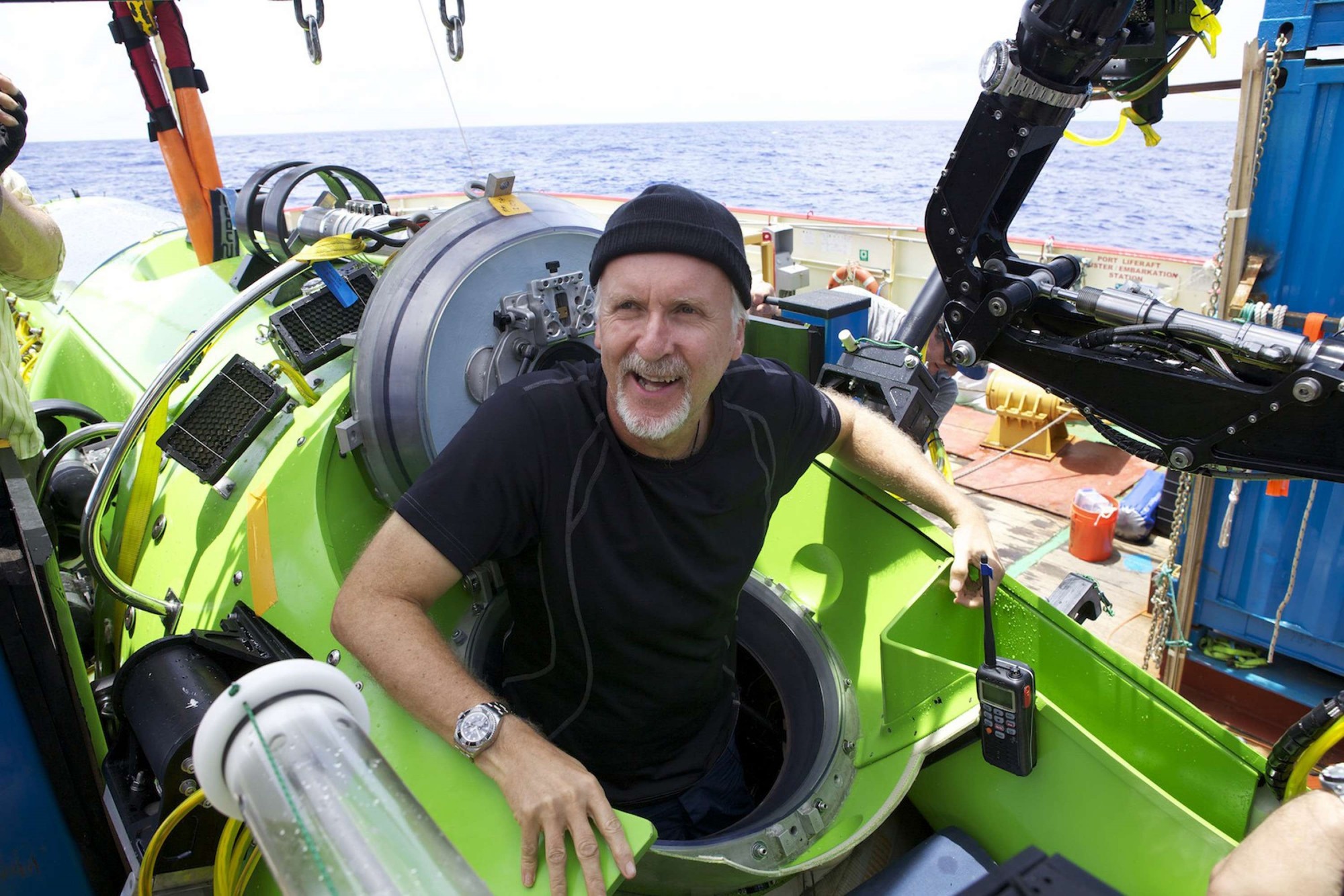
For Cameron, this was the realisation of a life-long dream. Image: Mark Theissen/NatGeoCreative.
James Cameron: Challenging the Deep at the Australian National Maritime Museum displays objects from the DEEPSEA CHALLENGE expedition and a lifetime of Cameron’s fascination with deep ocean exploration. One of the sweetest, and smallest, objects in the exhibition is a tiny cylindrical case of ballast from the Trieste that Cameron took with him to Challenger Deep. It is a memento that places his dive within a continuity of exploration to full ocean depth. It is both a symbol of what came before, and an avatar for expeditions to come.
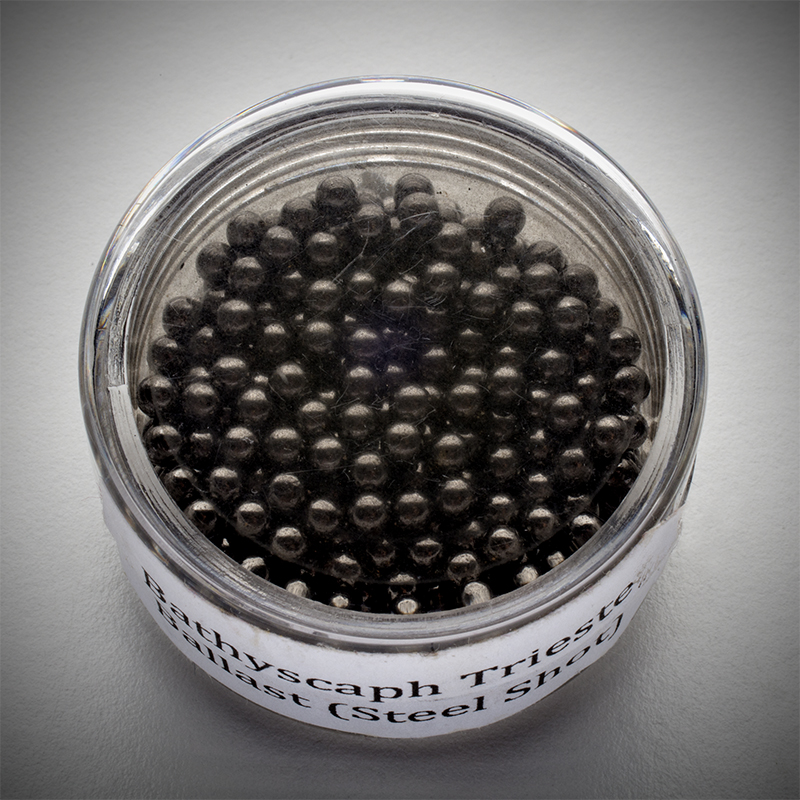
Connecting the TRIESTE and DEEPSEA CHALLENGER, James Cameron took a tiny cylindrical case of ballast from the TRIESTE with him to Challenger Deep. Image: ANMM.
To find out more about the DEEPSEA CHALLENGE expedition, visit James Cameron: Challenging the Deep, on now at the Australian National Maritime Museum.
References
- Cover image: DEEPSEA CHALLENGER. Photo by Mark Thiessen, National Geographic Creative.
- Pull quote: Walsh, Don ‘In the beginning… a personal view.' in: 2009 Marine Technology Society Journal, Into the Trench: Celebrating the Golden Anniversary of Man’s Deepest Dive, Part 1.
Further reading:
- The Hollow Steel Ball that Changed Ocean Exploration Forever
- Beebe, William. 1934. Half Mile Down. Harcourt, Brace and Company, New York.
- Piccard, Jacques and Robert Dietz. 1961 Seven Miles Down: the story of the bathyscaphe Trieste, Putnam, New York.
- National Geographic DEEPSEA CHALLENGE
- The Nonsuch Dive: A descent into the depths of the ocean
Credits
James Cameron – Challenging the Deep was developed by the museum’s USA Programs in collaboration with Avatar Alliance Foundation, supported by the USA Bicentennial Gift Fund, Destination NSW and National Geographic.

